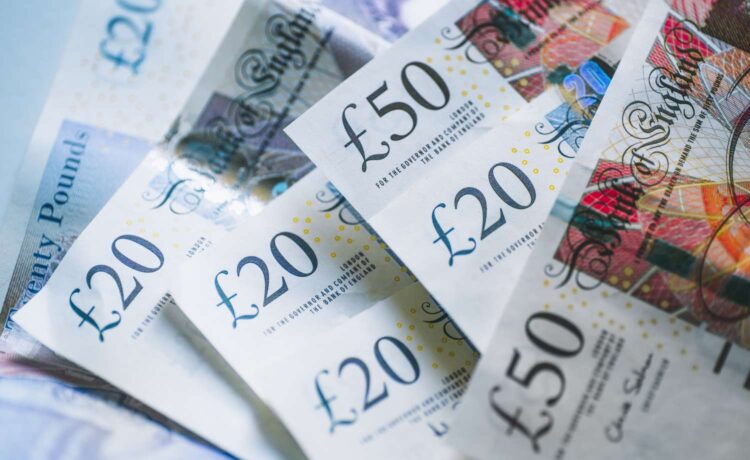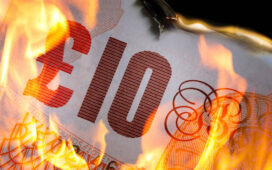The exchange rates between currencies vary over time, but the strongest economies do not always have the strongest global currencies. Long-term movements in currency prices are more important than exchange rates.
A currency is considered relatively strong if its value compared to another currency rises. A currency is considered relatively weak if its value falls relative to other currencies. This is why the British pound has historically been worth more than the U.S. dollar. However, even though the British pound (GBP) has a higher worth, the U.S. dollar (USD) is the world’s most traded currency and the world’s reserve currency.
Key Takeaways
- Despite the U.K.’s smaller economy, one British pound has historically been worth more than one U.S. dollar.
- The price of one currency compared to another is not necessarily an indication of wealth, power, or strength.
- Any current exchange rate indicates less about the relative strength of two currencies than the long-term trends in their price movements.
- A currency that increases in value against another over many years is generally considered to be a stronger currency.
- Even though the pound is worth more than the dollar, the U.S. dollar is still the world’s most frequently traded currency and the world’s reserve currency.
U.S. Dollar vs. British Pound
The long-term trends in the value of the GBP and the USD show that historically, one British pound has usually had a higher value than one U.S. dollar, even though the U.K. has a much smaller economy than the United States. This shows that the British pound is worth more than the U.S. dollar.
By some economic measures, however, the U.S. dollar is stronger than the British pound. The dollar’s status as the world’s reserve currency and its greater volume of trading in the forex markets are important indicators of strength. Additionally, the U.S. economy is a larger and stronger economy than that of the U.K., and so a greater value is placed on its currency, even if the exchange rate means that one dollar buys less than one pound sterling.
Understanding Currency Strength
Exchange rates between currencies often vary over time, though some are fixed to the specific value of another country’s currency. When one country’s currency is worth more than that of another in current exchange rates, however, it does not necessarily indicate a stronger economy or a currency with more overall worth.
Exchange rates are influenced by each country’s current economic activity, interest rates, gross domestic product (GDP), and unemployment rates. They are also influenced by the local market, and different currency exchanges in the same area will often offer different rates.
Looking at a currency’s worth relative to that of another currency at a static point in time is relatively meaningless when judging that currency’s inherent value. For example, the Japanese yen (JPY) is regarded as one of the world’s strongest currencies, yet a Japanese yen is worth only about one U.S. cent.
The best way to judge a currency’s strength is by observing the long-term trends in its relative value, or how its value changes in relation to other currencies over many years. Supply, demand, inflation, and other economic factors will cause changes to a currency’s relative price. It is these changes that ultimately determine the relative strength of a currency.
Exchange Rate Quoting Conventions
One indication of the strength of the British pound (GBP) is the way the currency is quoted relative to the U.S. dollar (USD) in exchange rates and foreign exchange (forex) markets. For example, an exchange rate between the GBP and USD might be quoted as 1.2500 GBP/USD, or $1.25 equals a pound.
This quoting convention has been the way the British pound has traditionally been quoted against the USD and other major currencies. Some other currencies are also quoted in this manner, such as EUR/USD—the single European currency, or euro (EUR), against the USD, where a EUR/USD exchange rate of 1.2000 means that one euro is worth 1.2000 U.S. dollars.
The quoting convention for the pound stems from the days of British Empire during the period of the late 1800s to late 1910s, during World War I. During this time, the U.K. economy was bigger than the U.S. economy. Quoting conventions are hard to change, and that has been the case even once the U.S. economy eclipsed the British economy in both value and size.
Purchasing Power Parity (PPP)
The other element to take into account when determining a currency’s relative worth is purchasing power parity, or PPP. This shows a currency’s worth is based on how much a basket of goods is valued in the two currencies. For example, using a rate of GBP/USD 1.2500, a basket of goods worth 100 pounds should cost 125 U.S. dollars.
Purchasing power parity is a theoretical construct that provides a kind of anchor against exchange rate movements. This means that the exchange rate between two currencies should not deviate significantly from their PPP.
The degree to which a currency deviates from its PPP is one popular measure of the relative strength or weakness against another currency. The difference between the market currency rate and PPP is usually attributed to speculative forces, which in turn are taking their cues from interest rate differentials and economic performance over time.
In the 20th Century
Decline of the British Pound
Although one British pound is worth a little less than one and a half U.S. dollars in 2024, it used to be worth a lot more. Britain had a global empire in 1900, and the British pound was worth almost five times as much as the U.S. dollar. World War I, World War II, and the breakup of the British Empire took a heavy toll on the pound, leaving the U.S. dollar as the primary currency of exchange.
USD As Global Reserve Currency
The U.S. overtook the British Empire as the largest economy in the 1890s, and the dollar became the world’s reserve currency in the 1920s, shortly after World War I. In the 20th century,
Currently, nearly all commodities (oil, grains, and metals) are priced in U.S. dollars. The U.S. dollar also accounts for 60% or more of currency reserves held by other countries. In times of market upheaval, such as plunging stock markets or worries about global economic disruption, the USD is considered the ultimate safe-haven currency.
Depreciation and Growth
During much of the 20th century, the British pound depreciated against the U.S. dollar. This decline made the pound a weak currency, even though it was worth more than the dollar. By the 1980s, the value of the British pound hit a bottom. Between the 1980s and 2021, the pound stabilized against the dollar and usually traded for between one and two U.S. dollars.
Safe Haven Currencies
A safe haven currency retains its value during turbulent economic times. The Swiss franc (CHF), Japanese yen, and U.S. dollar are safe haven currencies. The U.S. dollar is a popular safe haven currency due to its massive liquidity, its prevalence as a reserve currency, and the credibility of the U.S. Treasury and the Federal Reserve.
The JPY is also considered a safe-haven currency due to perpetual trade surpluses and the fact that nearly 50% of Japanese debt is held by the Bank of Japan. The CHF gets its safe-haven status primarily because one-third of global assets are held in Switzerland. When markets need to bring money home, which is the natural inclination during times of market turmoil, the three main destinations are the USD, the JPY, and the CHF.
What Makes a Currency Rise or Fall in Value?
Many factors impact currency value, but the most important variable is interest rate differentials. This means the currency with the higher relative interest rates strengthens against the currency with lower relative interest rates. Other factors that affect currency value include a country’s trade balance, economic outlook, interest rate expectations, and overall market sentiment.
How Has the Value of the British Pound Changed Compared to the U.S. Dollar?
In the late 19th century, the British pound was valued five times higher than the dollar. Over the 20th century—due to the two World Wars, the loss of the British Empire, and other negative factors—the British pound lost value and significantly depreciated, to a point where it now typically sits between one and two dollars.
The value of the GBP can fluctuate significantly against the USD. For example, from January 2022 to October 2022, the pound and the dollar strengthened, bringing GBP/USD from around 1.3700 to 1.0800. This was a change of nearly 25%.
What Is a Good Exchange Rate for Pounds to Dollars?
A good exchange rate for pounds to dollars varies over time. If the GBP/USD rate is high, say, 1.7500, it will take $1.75 to buy one British pound. If the USD has strengthened or the GBP has weakened, and the GBP/USD rate could be 1.2500, and it would take only $1.25 to buy one pound. Exchange rates can also vary by dealers, so shopping around before exchanging currency can help you find the best rate.
The Bottom Line
The British pound is worth more than the U.S. dollar on a nominal basis and, historically, has a higher worth as judged by long-term movements in its value. However, the dollar the U.S. economy is a larger and stronger economy than that of the U.K., and so a greater value is placed on its currency in the global economy, even if the exchange rate means that one dollar buys less than one pound sterling.





